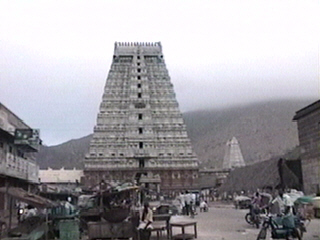Abodes of Ganesha
Temples of Tamilnadu
|

Tiruvannamalai
Temples
of Tamilnadu
The temple town of Tiruvannamalai
Tiruvannamalai the home of Annamalayaar or Arunachaleswarar (Shiva worshipped as a Shiva Lingam) and Unnamulaiyaal (Apitakuchambaal - Parvati), is one of the largest temples in India.
It occupies a special place in the Saivite realm and is regarded as one of the Pancha Bhoota Stalams (one of the five grand temples associated with the five basic elements) – associated with the element Fire, the other four being Tiruvanaikkaval (Water), Chidambaram (Space), Kanchipuram (Earth) and Sri Kalahasti (Wind) respectively.
Legend has it that Shiva manifested himself in the form of a massive column of fire, whose crown and feet, Bhramma and Vishnu attempted in vain to reach. (See: Lingodbhavar) A celebration of this manifestation is seen today in the age old traditions observed in the Shivaratri and the Kartikai Deepam Utsavams held here.
There is an air of deep mysticism around the temple, the hill and its environs and the town itself has been known for its long association with Yogis, Siddhas, the well known spiritual savant Ramana Maharishi and several others. The origin of this temple dates way back in time, although much of the temple structure as seen today, is a result of building activity over the last one thousand years.
Seventh century Tamil poetry glorifies this temple. All of the four Saivite Saints Appar, Sambandar, Manikkavacakar and Sundarar have sung the glory of this temple and it was at this temple that Arunagirinathar began composing his immortal work Tiruppugazh. Muthuswamy Deekshitar’s kriti Arunachalanatham pays tribute to the presiding deity of Tiruvannamalai.
